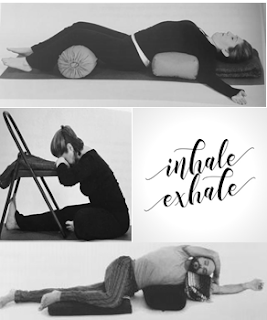“You can expect side effects
including some pretty intense hot flashes for at least six months.”
My doctor shared this information with me as I recently began taking an FDA-approved drug for breast cancer risk reduction. However, she also told me that if I continued my daily gentle and restorative yoga practices, the intensity would lessen and the duration would decrease.
My doctor wasn’t kidding about the intensity! Running in August, in Florida, was hot enough but running with hot flashes was miserable. I also had trouble falling and staying asleep. Thankfully, within a month and a half of beginning the medication, and continuing my yoga practices, the intense hot flashes ceased. When I ran, I no longer felt like I was burning inside and melting outside. My quality of life definitely improved. Plus, I was able to enjoy undisturbed sleep. Yoga is not decreasing my breast cancer risk, the medication is doing that, but yoga has a positive effect on my physical and mental health... and I am not the only one who has experienced the therapeutic effects of yoga!
From my personal experience, one may suppose that yoga is “good” for cancer patients and survivors but finding out, through research, is better. In a previous post I discussed yoga research in general. In this post, and in honor of Breast Cancer Awareness Month, I want to highlight a few research studies specifically related to breast cancer and gentle or restorative yoga.
First, it is important to understand that yoga is not a cure for cancer. However, yoga does have a therapeutic effect on the consequences of a cancer diagnosis and the side effects of treatments. The cancer comorbidities and symptoms listed below are what scientists are studying in relation to yoga practice.
First, it is important to understand that yoga is not a cure for cancer. However, yoga does have a therapeutic effect on the consequences of a cancer diagnosis and the side effects of treatments. The cancer comorbidities and symptoms listed below are what scientists are studying in relation to yoga practice.
In fact, research studies have documented the benefits of yoga for cancer comorbidities and symptoms.
What follows is a very small sampling of recent studies and review papers. This evidence-based research explains yoga’s therapeutic efficacy when used in conjunction with conventional medicine.
REVIEW PAPERS: The purpose of a review paper is to succinctly review recent research in a particular topic. It discusses the findings presented in recent research papers. Then the paper summarizes the current state of knowledge of the topic.
- Low-intensity forms of yoga, specifically gentle hatha and restorative, are feasible, safe, and effective for treating sleep disruption, cancer-related fatigue, cognitive impairment, psycho-social distress, and musculoskeletal symptoms in cancer patients receiving chemotherapy and radiation and cancer survivors.
Yoga for the Management of Cancer Treatment-Related Toxicities (Full Text Article)
https://www.ncbi.nlm.nih.gov/pmc/articles/PMC5901971/
https://www.ncbi.nlm.nih.gov/pmc/articles/PMC6388460/pdf/10.1177_2515690X19828325.pdf
https://www.ncbi.nlm.nih.gov/pmc/articles/PMC5901971/
- This meta-analysis demonstrated that yoga is probably as effective as other exercise modalities in improving the Quality of Life of women with breast cancer.
https://www.ncbi.nlm.nih.gov/pmc/articles/PMC6388460/pdf/10.1177_2515690X19828325.pdf
- Sedentary breast and ovarian cancer survivors were randomized to practice either restorative yoga (minimal physical exertion) or vigorous yoga (considerable physical exertion). Restorative yoga is a more feasible intervention for this population.
https://www.ncbi.nlm.nih.gov/pmc/articles/PMC7470896/
NOTABLE PUBLICATIONS: These are individual, published studies that are notable for scientific, clinical, epidemiological, sociological, and/or policy aspect.
- Participants in Restorative Yoga experienced increases in emotional well-being and less fatigue than those in a control group. This type of intervention should be considered for women undergoing multi-modality treatment for breast cancer.
- Significant improvements were seen for depression, negative affect, state anxiety, mental health, and overall quality of life.
- Depression scores at follow-up were significantly lower in the yoga group compared to the control group.
https://pubmed.ncbi.nlm.nih.gov/28411330/
Restorative yoga is not a cure. But many breast cancer patients and survivors have found it to be a powerful tool to manage the daily challenges of cancer treatments as well as the side effects and life-long vulnerabilities they create.
To find out more:
Yoga Alliance has curated an online listing of cancer & yoga research studies.
Yoga4cancer has published a review of existing research on the benefits of yoga for cancer patients and survivors and how yoga manages short- and long-term side effects faced by most cancer survivors. It was developed by a team of medical writers, oncologist, researchers and yoga4cancer team. Yoga4Cancer White Paper
National Cancer Institute/Advances in Breast Cancer Research: This page highlights some of the latest research in breast cancer, including clinical advances that may soon translate into improved care, NCI-supported programs that are fueling progress, and research findings from recent studies.
Online Medical Research Search Engine: PubMed. gov, National Institutes of Health’s National Library of Medicine is comprised of more than 30 million citations for biomedical literature from MEDLINE, life science journals, and online books. Citations may include links to full-text content from PubMed Central and publisher web sites.
Helpful books:
The Emperor of All Maladies: A Biography of Cancer by Siddhartha Mukherjee, MD
Yoga and Breast Cancer by Ingrid Kollak, RN, PhD, & Isabell Utz-Billing, MD
Yoga for Cancer by Tari Prinster, E-RYT 200















